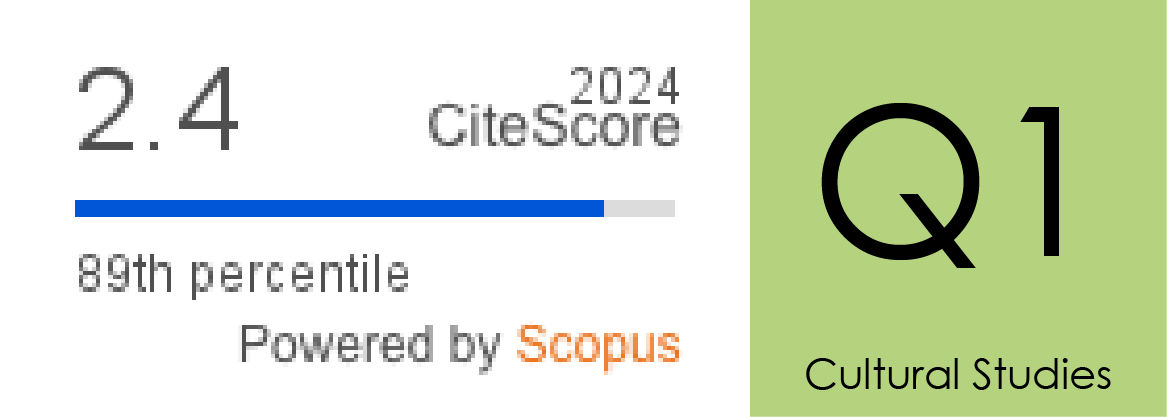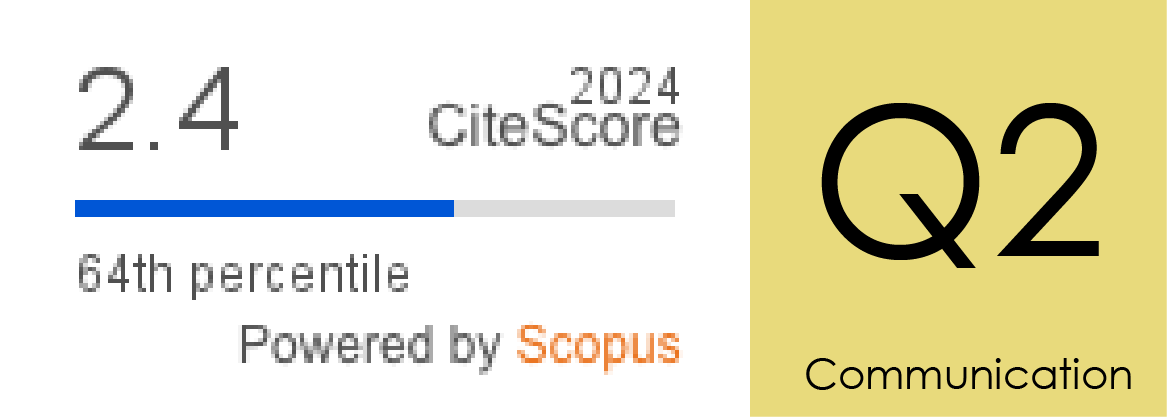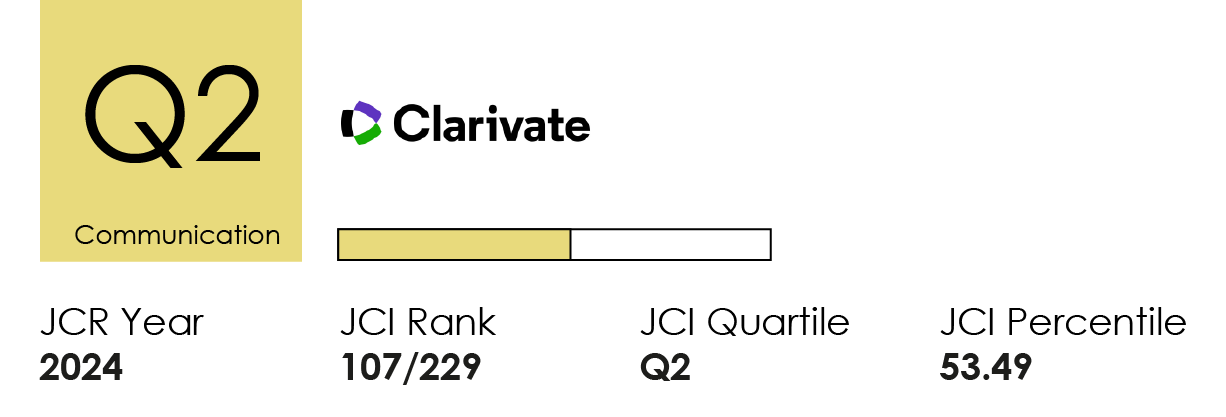Liderazgo de opinión, innovación y actitud de los consumidores de moda portugueses
DOI:
https://doi.org/10.14198/MEDCOM2016.7.2.12Palabras clave:
Liderazgo de opinión, Actitud hacia la publicidad, Innovación, Moda, Comportamiento del consumidorResumen
Este estudio tiene como principal objetivo analizar el liderazgo de opinión en el contexto del mercado de la moda, más concretamente, verificar si existe una correlación entre las variables liderazgo de opinión, adhesión a la innovación en la moda y actitud hacia la publicidad de la moda. A partir dela variable liderazgo de opinión, se pretende también identificar dos grupos diferentes de consumidores: los líderes de opinión y los seguidores en el mercado de la moda. Se seleccionaron 203 estudiantes de tercer ciclo y de postgrado de dos universidades de Oporto, la segunda ciudad más grande de Portugal. Fue solicitado a los participantes que rellenasen un cuestionario sobre actitudes y comportamientos sobre moda. Los resultados muestran que existe una correlación positiva entre la adhesión a la innovación, el liderazgo de opinión y la actitud hacia la publicidad. Fue posible identificar dos grupos de consumidores. Por un lado, “los influyentes”, que puntúan moderadamente en la variable adhesión a la innovación y presentan una actitud positiva hacia la publicidad de la moda, y por otro, “los seguidores”, que no se consideran ni innovadores ni líderes de opinión, pero mantienen una actitud positiva moderada hacia la publicidad de la moda.
Citas
BEAUDOIN, P. & GOLDSMITH, R. E. (1998). Consumers' ethnocentrism and fashion leadership. Psychological Reports, 83(3), 239-1248. http://dx.doi.org/10.2466/pr0.1998.83.3f.1239
BIRTWISTLE, G. & MOORE, C. (2006). Fashion innovativeness in the UK: a replication study. Proceedings of Australian and New Zealand Marketing Academy Conference - ANZMAC, Brisbane, Australia, 4–6 December 2006.
BLANKSON, C.; SPEARS, N. & HINSON, R. (2012). West African Immigrants’ Perceptions of Advertising in General and Impact on Buying Decisions. Journal of International Consumer Marketing, 24, 168–185. http://dx.doi.org/10.1080/08961530.2012.682038
CARDOSO, P. R.; COSTA, H. & NOVAIS, L. (2010). Fashion consumer profiles in the Portuguese market: involvement, innovativeness, self-expression and impulsiveness as segmentation criteria. International Journal of Consumer Studies, 34(6), 638–647. http://dx.doi.org/10.1111/j.1470-6431.2010.00891.x
CLARK, R. & GOLDSMITH, R. (2006). Global innovativeness and consumer susceptibility to interpersonal influence. Journal of Marketing Theory and Practice, 14, 275–285. http://dx.doi.org/ 10.2753/MTP1069-6679140402
CHOO, H.; SIM, S.; LEE, H. & KIM, H. (2014). The effect of consumers’ involvement and innovativeness on the utilization of fashion wardrobe. International Journal of Consumer Studies, 38(2), 175–182. http://dx.doi.org/10.1111/ijcs.12078
DU PREEZ, R.; VISSER, E. & ZIETSMAN, L. (2007). Lifestyle, shopping orientation, patronage behaviour and shopping mall behaviour – a study of South African male apparel consumers. European Advances in Consumer Behavior, 8, 279–280.
FEICK, L. & PRICE, L. (1987). The market maven: A diffuser of marketplace information. Journal of Marketing, 51, 83-97. http://dx.doi.org/10.2307/1251146
FLYNN, L.R., GOLDSMITH, R.E. & EASTMAN, J.K. (1996). Opinion leaders and opinion seekers: two new measurement scales. Journal of the Academy of Marketing Science, 24, 137–147. http://dx.doi.org/10.1177/0092070396242004
GOLDSMITH, R. E., & HOFACKER, C. F. (1991). Measuring consumer innovativeness. Journal of the Academy of Marketing Science, 19, 209–221. http://dx.doi.org/10.1177/009207039101900306
GOLDSMITH, R. & STITH, M. (1993). The social values of fashion innovators. Journal of Applied Business Research, 9(1), 10–17. http://dx.doi.org/10.19030/jabr.v9i1.6089
GOLDSMITH, R.; D´HAUTEVILLE, F. & FLYNN, L. (1998). Theory and measurement of consumer innovativeness: A transnational evaluation. European Journal of Marketing, 32(3/4), 340-353. http://dx.doi.org/10.1108/03090569810204634
GREWAL, R.; MEHTA, R. & KARDES, F. (2000). The role of the social-identity function of attitudes in consumer innovativeness and opinion leadership. Journal of Economic Psychology, 21(3), 233-252. http://dx.doi.org/10.1016/S0167-4870(00)00003-9
GUTMAN, J. & MILLS, M. (1982). Fashion life style, self-concept, shopping orientation, and store patronage: an integrative analysis. Journal of Retailing, 58(2), 64–86.
IM, S., BAYUS, B. & MASON, C. (2003). An empirical study of innate consumer innovativeness, personal characteristics, and new product adoption behavior. Journal of the Academy of Marketing Science, 31(1), 61–73. http://dx.doi.org/10.1177/0092070302238602
INE - INSTITUTO NACIONAL DE ESTATÍSTICA (2015). Inquérito de Conjuntura às empresas e aos consumidores. Destaque, Março 2015, 1-16.
JANSSEN, D. M. & PAAS, L. J. (2014). Moderately thin advertising models are optimal, most of the time: Moderating the quadratic effect of model body size on ad attitude by fashion leadership. Marketing Letters, 25(2), 167–177. http://dx.doi.org/10.1007/s11002-013-9249-y
JORDAAN, Y. & SIMPSON, M. (2006). Consumer innovativeness among females in specific fashion stores in the Menlyn shopping center. Journal of Family Ecology and Consumer Sciences, 34, 32–40.
KATZ, E. & LAZARSFELD, P. (2006). Personal influence: the part played by people in the flow of mass communications. New Brunswick: Transaction Publishers.
KELLER, E. B., & BERRY, J. (2003).The Influentials. New York: Simon & Schuster.
KELLER, E. & FAY, B. (2009). The Role of Advertising in Word of Mouth. Journal of Advertising Research, 49(2), 154-158. http://dx.doi.org/ 10.2501/S0021849909090205
KIM, S. & MARTINEZ, B. (2012). Fashion consumer groups and online shopping at private sale sites. International Journal of Consumer Studies, 37(4), 367–372. http://dx.doi.org/10.1111/j.1470-6431.2012.01102.x
LEUNG, L. (1998). Lifestyles and the use of new media technology in urban China. Telecommunications Policy, 22(9), 781-90. http://dx.doi.org/10.1016/S0308-5961(98)00055-X
MA, F.; SHI, H.; CHEN, L. & LUO, Y. (2012). A Theory on Fashion Consumption. Journal of Management and Strategy, 3(4), 84-92. http://dx.doi.org/10.5430/jms.v3n4p84
MARINOV, M.; PETROVICI, D. & MARINOVA, S. (2008). Consumer Attitudes Toward Advertising in Bulgaria and Romania. Joumal of Euromarketing, 17(2), 81-93. http://dx.doi.org/10.1080/10496480802134662
MARTIN, C. R. (1971). What Consumers of Fashion Want to Know. Journal of Retailing, 47(4), 65-73.
MARTÍN-CABELLO, A. (2016). El dessarrollo histórico del sistema de la moda: una revisión teórica. Athenea Digital, 16(1), 265-289. http://dx.doi.org/10.5565/rev/athenea.1338
MARTIN-SANTANA, J. & BEERLI-PALACIO, A. (2008). Why Attitudes Toward Advertising Are Not Universal: Cultural Explanations. Journal of Euromarketing, 17(3/4), 159-181. http://dx.doi.org/10.1080/10496480802511299
MATHUR, A. (2012). Consumer Acculturation in the Age of Globalization: A Study of First-Generation Indian Immigrants in the United States. Journal of International Consumer Marketing, 24, 372–384. http://dx.doi.org/10.1080/08961530.2012.741480
MCDONALD, H. & ALPERT, F. (2007). Who are “innovators” and do they matter? A critical review of the evidence supporting the targeting of “innovative” consumers”. Marketing Intelligence & Planning, 25(5), 421-435. http://dx.doi.org/10.1108/02634500710774923
MEHTA, A. & PURVIS, S. (1995). When Attitude Towards Advertising in General Influence Advertising Success. Proceedings of Conference of the American Academy of Advertising, Baylor University, Norfolk, VA, Waco, TX., 1995.
MERWE, R. & HEERDEN, G. (2009). Finding and Utilizing Opinion Leaders: Social Networks and the Power of Relationships. South African Journal of Business Management, 40(3), 65–76.
MILES, S. (1998). Consumerism: as a way of life. London: Page Publications.
MIRIAM, T. (1982). Skill and Motivation in Cloths Shopping: Fashion-conscious, Independent, Anxious, and Apathetic Consumers. Journal of Retailing, 58(4), 90-98.
MUEHLING, D. (1987). An Investigation of Factors Underlying Attitude Toward Advertising in General. Journal of Advertising, 16(1), 32-40. http://dx.doi.org/10.1080/00913367.1987.10673058
MUZINICH, N., PECOTICH, A., & PUTREVU, S. (2003). A model of the antecedents and consequents of female fashion innovativeness. Journal of Retailing and Consumer Services, 10, 297-310. http://dx.doi.org/10.1016/S0969-6989(02)00060-7
NUNNALLY, J. C. (1978). Psychometric theory (2nd ed.). New York: McGraw-Hill.
O’CASS, A. (2000). An assessment of consumers product, purchase decision, advertising and consumption involvement in fashion clothing. Journal of Economic Psychology, 21(5), 545–576. http://dx.doi.org/10.1016/S0167-4870(00)00018-0
PETROVICI, D. & PALIWODA, S. (2007). An empirical examination of public attitudes towards advertising in a transitional economy. International Journal of Advertising, 26(2), 247–276. http://dx.doi.org/10.1080/10803548.2007.11073009
POLLAY, R. & MITTAL, B. (1993). Here's the Beef: Factors, Determinants and Segments in Consumer Criticism of Advertising. Journal of Marketing, 57(3), 99-114. http://dx.doi.org/10.2307/1251857
RABOLT, N. J. & MILLER, J. K. (1997). Concepts and cases in retail and merchandising management. New York: Fairchild Publications.
ROGERS, E. (1995). Diffusion of Innovation. New York: The Free Press.
RUVIO, A. & SHOHAM, A. (2007). Innovativeness, Exploratory Behavior, Market Mavenship, and Opinion Leadership: An Empirical Examination in the Asian Context. Psychology & Marketing, 24(8), 703–722. http://dx.doi.org/10.1002/mar.20180
SEGEV, S.; VILLAR, M. E. & FISKE, R. (2012). Understanding Opinion Leadership and Motivations to Blog: Implications for Public Relations Practice. Public Relations Journal, 6(5).
SHERIFF, A., & NAGESH, P. (2007). The advertising challenge: Understanding the multifaceted youth. ICFAI Journal of Consumer Behavior, 2(4), 59–65.
STENG, W. (2001). The textile and clothing industry in the EU - A survey. Enterprise Papers, No. 2. European Communities, Available in: http://www.uni-mannheim.de/
STITH, M. & GOLDSMITH, R. (1989). Race, sex, and fashion innovativeness: a replication. Psychology & Marketing, 6, 249–262. http://dx.doi.org/10.1002/mar.4220060403
Teixeira, S. (2013). The importance of the catalogs for the Portuguese clothing sector. Aesthetic and graphic quality of the catalogs. Proceedings of the International Marketing Trends Conference. ESCP Europe, Venice.
VERNETTE, E. (2004). Targeting Women's Clothing Fashion Opinion Leaders in Media Planning: An Application for Magazines. Journal of Advertising Research, 44(1), 90–107. http://dx.doi.org/10.1017/S0021849904040061
WALSH, G., HENNIG-THURAU, T., WAYNE-MITCHELL, V. & WIEDMANN, K. (2001), “Consumers' decision-making style as a basis for market segmentation”. Journal of Targeting, Measurement & Analysis for Marketing, 10(2), 117-131. http://dx.doi.org/10.1057/palgrave.jt.5740039
WANG, Y. & CHO, H. (2012). The effect of fashion innovativeness on consumer´s online apparel customization. The International Journal of Organizational Innovation, 5(2), 263-283.
WORKMAN, J. & STUDAK, C. (2006). Fashion consumers and fashion problem recognition style. International Journal of Consumer Studies, 30(1), 75–84. http://dx.doi.org/10.1111/j.1470-6431.2005.00451.x
Estadísticas
Publicado
Cómo citar
Número
Sección
Licencia
Derechos de autor 2016 Paulo Ribeiro Cardoso, Sandrina Teixeira, Ana Luísa Santos

Esta obra está bajo una licencia internacional Creative Commons Atribución-CompartirIgual 4.0.
Los autores y autoras que publican en esta revista están de acuerdo con los siguientes términos:
1 Derechos de autor. Los autores y autoras conservan sus derechos de autor, aunque ceden a la revista de forma no exclusiva los derechos de explotación (reproducción, distribución, comunicación pública y transformación) y garantizan a esta el derecho de primera publicación de su trabajo, el cual estará simultáneamente sujeto a la licencia indicada en punto 2. Los autores pueden establecer otros acuerdos adicionales para la distribución no exclusiva de la versión de la obra publicada en la revista, siempre que exista un reconocimiento de su publicación inicial en esta revista.
© Los autores.
2 Licencia. Los trabajos se publican en la revista sujetos a la licencia de Reconocimiento 4.0 Internacional de Creative Commons (CC BY 4.0); los términos se pueden consultar en https://creativecommons.org/licenses/by/4.0/
Esta licencia permite a terceros compartir (copiar y redistribuir el material en cualquier medio o formato) y adaptar (remezclar, transformar y crear a partir del material para cualquier finalidad, incluso comercial), siempre que se reconozca la autoría y la primera publicación en esta revista (Revista Mediterránea de Comunicación (RMC) / Mediterranean Journal of Communication (MJC), Universidad de Alicante, DOI de la obra), se proporcione un enlace a la licencia y se indique si se han realizado cambios en la obra.
3 Política de autoarchivo. Se recomienda a los autores que difundan sus trabajos a través de Internet para favorecer una circulación y difusión más rápidas y, con ello, un posible aumento en la citación y alcance entre la comunidad científica y académica, en las siguientes condiciones:
No se permite a los autores depositar en un repositorio institucional o temático, página web propia, etc., las versiones preprint (versión antes de ser evaluada) o postprint (versión evaluada y aceptada para su publicación) de sus trabajos antes de su publicación, pero sí el artículo final publicado (versión del editor).













